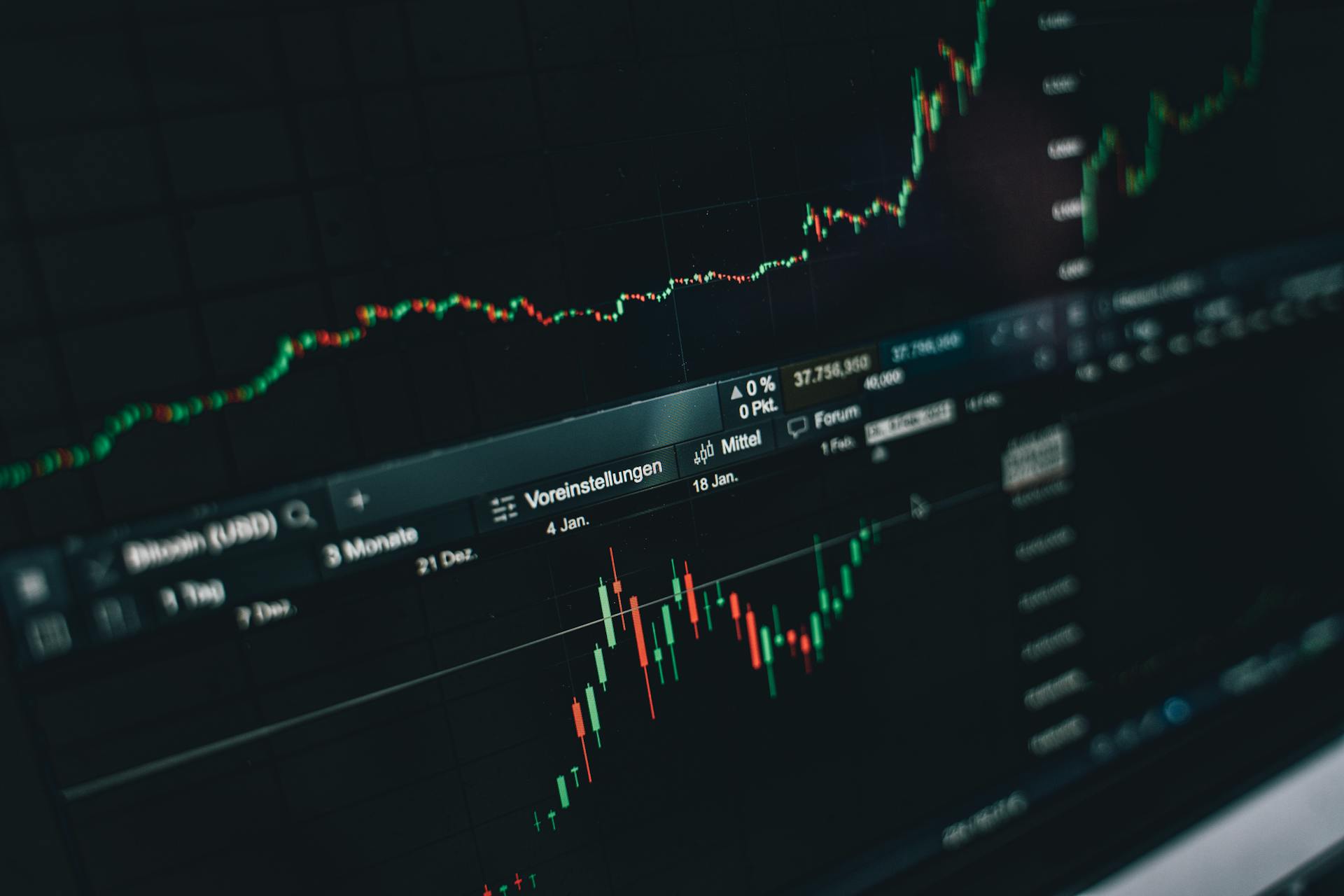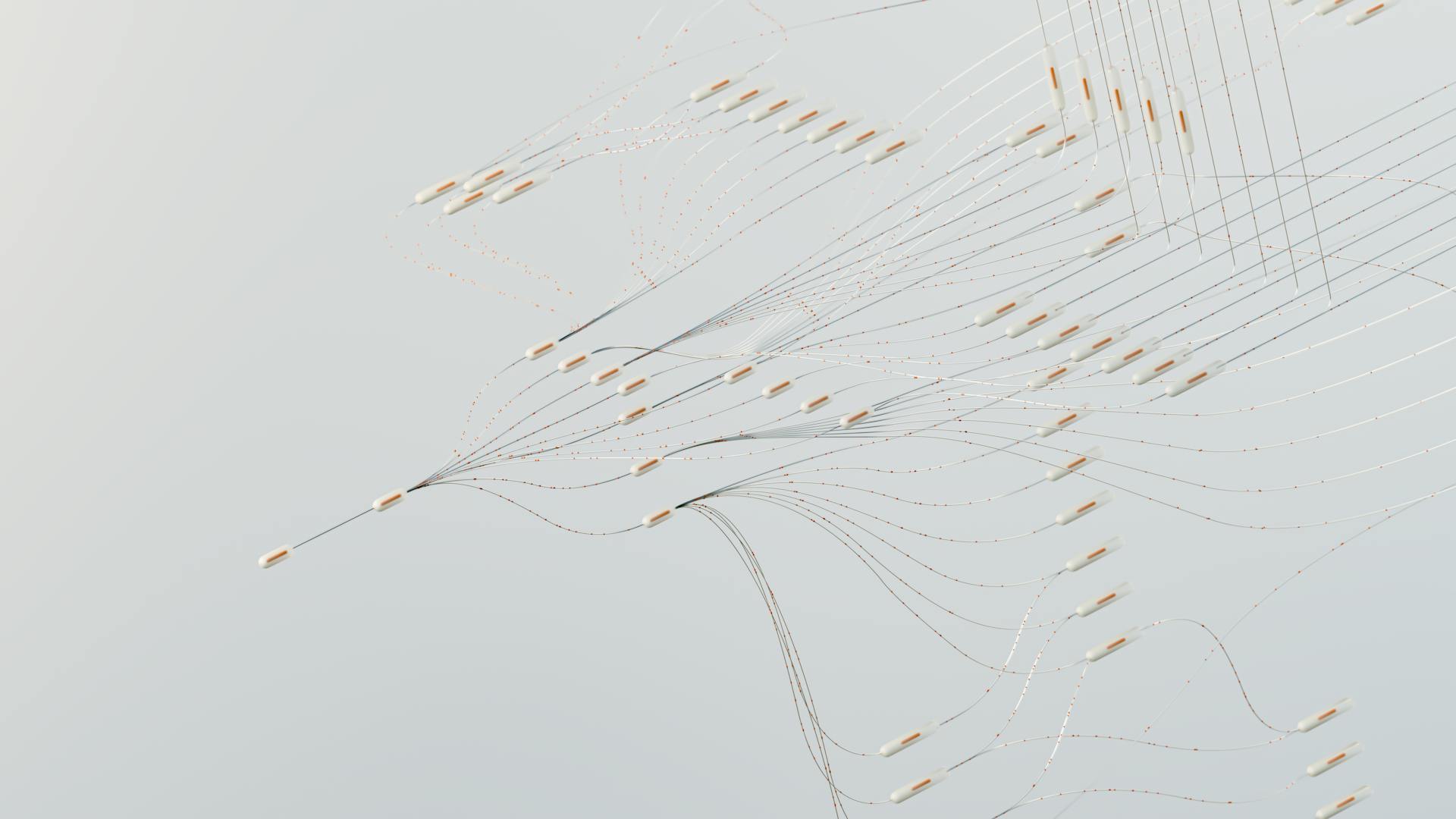
Bitcoin miners are leveraging AI compute to transform data centers and infrastructure. This shift has led to significant improvements in energy efficiency and scalability.
The use of AI-powered cooling systems has resulted in a 30% reduction in energy consumption. This is a major breakthrough for the industry.
As AI compute becomes more prevalent, data centers are being designed with flexibility and modularity in mind. This allows for easier upgrades and more efficient use of resources.
The integration of AI and blockchain technology is also enabling the creation of decentralized data centers. These centers can be located anywhere, reducing the need for centralized infrastructure.
Expand your knowledge: How to Use Bitcoins
Miners Turn to AI
Bitcoin miners are pivoting to AI due to the synergy between the two industries, with AI companies needing energy and bitcoin miners having it in abundance.
Five publicly traded bitcoin miners already have working High-Performance Computing (HPC) capacity, including Core Scientific, Iren, Bit Digital, Hive Digital, and Hut 8.
Recommended read: Bit Coin Miners
Bitcoin stocks Bitdeer Technologies, Bitfarms, Cipher Mining, and TeraWulf are exploring AI opportunities or testing pilot programs.
Profits from bitcoin mining fell to an all-time low in August, which may prompt miners to diversify into AI to stay afloat.
Bitcoin miners have a related skill set for HPC/AI that is well-suited to meet the insatiable demand for compute power, as noted by Bit Digital CEO Sam Tabar.
The demand for AI services is rising across various sectors, making the transition to AI a potentially essential move for bitcoin miners.
Bitcoin miners can adapt their existing infrastructure to accommodate AI workloads, streamlining operations and optimizing energy use, which positions them favorably in the rapidly growing AI landscape.
Data Center and Infrastructure
Building an HPC-grade data center from scratch can take three to five years, but this timeline has been stretched due to a growing waitlist for grid connections for AI projects.
Construction costs for these new data centers can range from $12 million to $20 million per megawatt, depending on size, design, and redundancy requirements.
One gigawatt of power is enough energy to power 750,000 homes.
Bitcoin miners, on the other hand, offer a much faster path to AI data processing, with some managing more than 5 gigawatts of power and access to another 4.5 gigawatts in various phases of construction and approvals.
Faster Data Center Buildouts
Building a data center from scratch can take anywhere from three to five years, but this timeline has been stretched due to a growing waitlist for grid connections for AI projects.
Construction costs for new data centers can range from $12 million to $20 million per megawatt, depending on size, design, and redundancy requirements.
Companies with access to cheap power today can save a lot of money, and acquiring or partnering with a bitcoin miner could be worth $140 million per megawatt for hyperscalers like Microsoft or Amazon Web Services.
One gigawatt of power is enough energy to power 750,000 homes.
HPC GPU servers require far more versatile and powerful processors designed for parallel processing, which is essential for tasks like machine learning and neural network training.
Additional reading: Crypto Mining Earnings per Day
Iren Is Capex-Intensive
Iren, a company formerly called Iris Energy, is a prime example of a capex-intensive AI model. It owns 816 Nvidia H100 GPUs for its AI services business, which it acquired for a significant amount.
The company generated $3.1 million in AI cloud services revenue in its latest year, starting to collect AI revenue in Q3. This revenue is a result of its AI services business.
Iren generates $2 to $2.50 in revenue per GPU hour, which only costs $0.06 per hour in electricity. This means it's making a substantial profit from its AI services.
The company expects its 816 AI GPUs to generate $14 million to $17 million in annualized profit. This is a significant increase in revenue.
Iren's payback period is just 24 months, which is impressive considering the initial investment. This indicates that the company is well-positioned to take advantage of the HPC and AI opportunity.
Take a look at this: How to Trade Bitcoins for Profit
Hardware and Technology
Bitcoin miners are upgrading their hardware to handle AI workloads, a significant shift from their traditional focus on cryptocurrency mining.
The upgrade process is surprisingly cost-effective, with Core Scientific estimating it costs between $5 million to $7 million for their upgrades.
Comparing bitcoin miners to HPC GPU servers is like comparing a Hyundai to a Lamborghini - the former is built for a singular task, while the latter is designed for high-performance computing.
Retrofitting existing bitcoin mining facilities to accommodate AI workloads is a more affordable option than building new data centers from scratch.
Bitcoin miners already possess the necessary computing power and infrastructure to support AI operations, making the transition relatively seamless.
By leveraging their existing resources, bitcoin miners can significantly reduce the time to market when launching AI initiatives, giving them a competitive edge in the rapidly growing AI landscape.
Recommended read: Computing Depreciation Expense
AI Compute Models
Two business models have emerged for bitcoin miners expanding to AI: a capex light model and a more capex-intensive approach.
The capex light model involves leasing data center space to hyperscalers that buy and supply their own GPUs, while the capex-intensive model requires miners to finance and operate their own GPUs and sell compute capacity to AI clients.
See what others are reading: What Are Gpus in Bitcoin Miner
Miners using the capex-intensive model can generate $1,540 to $3,950 per megawatt hour, excluding power costs, according to JPMorgan's estimates.
For the capex-light model, the firm puts revenue closer to $118 per MWh, with power costs passed through to the client.
This model is low-cost for miners but generates less revenue, earning around $118 per MWh, with power costs passed to the client.
The synergy between Bitcoin mining and AI computing stems from the miners' access to abundant energy resources and existing data center infrastructure.
As AI development intensifies, the demand for energy-intensive computing facilities has surged, creating a natural fit for mining operations looking to diversify.
Miners can earn around $118 per MWh, with power costs passed to the client, under the AI Hosting Model (Light).
Cost and Profit
Bitcoin miners currently have 6.73 GW of power capacity, targeting 14,714 MW by 2027.
The miners' goal is ambitious, but it's not just about the power - it's also about the profit. VanEck estimates that converting 20% of their power capacity to AI and HPC by 2027 could lead to an additional annual profit of over $13.9 billion over 13 years.
This translates to a net present value of $37.6 billion, assuming a 17% discount rate. That's a significant sum, but it's not the only consideration - the miners also need to think about the cost of implementing this plan.
Many miners are likely to pursue a hosting model, like Core Scientific, which would lower their margin potential but also slash the required investment.
Revenue Growth
Bitcoin miners are shifting their focus to AI and high-performance computing, and it's expected to unlock a significant revenue boost.
According to VanEck's head of digital assets research, Matthew Sigel, this strategic pivot could unlock $38 billion in value for mining companies by 2027.
The synergy between Bitcoin mining and AI computing stems from the miners' access to abundant energy resources and existing data center infrastructure.
This is a natural fit, as AI development intensifies and the demand for energy-intensive computing facilities has surged.
Many miners are leaning toward this complementary strategy, as noted by Sigel, who also mentioned that cloud services help optimize capital costs and diversify revenue streams.
HIVE Blockchain, for example, has rebranded to HIVE Digital to reflect its evolving business, which now focuses on both BTC mining and supporting the HPC and AI industries.
The company expects this new venture to double its revenues, and has announced the construction of a new hydroelectric data center to support this growth.
Sources
- https://www.investors.com/news/bitcoin-miners-stocks-ai-data-centers/
- https://www.coindesk.com/business/2024/10/23/bitcoin-miners-are-pivoting-to-ai-to-survive-core-scientific-entered-the-race-years-ago
- https://foreman.mn/blog/bitcoin-mining-ai/
- https://www.financemagnates.com/cryptocurrency/wall-street-bitcoin-miners-pivot-to-ai-eyeing-38-billion-opportunity/
- https://dailyhodl.com/2024/08/18/bitcoin-miners-shifting-to-artificial-intelligence-and-high-performance-computing-according-to-vaneck-analysts/
Featured Images: pexels.com


